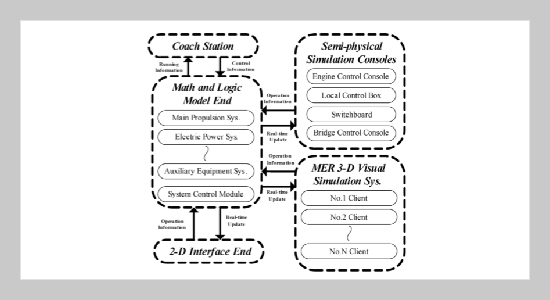REFERENCES
- [1] Orosa, J. A., “Computer Software for Reducing the Learning Time of Marine Engineers,” Computer Applications in Engineering Education, Vol. 19, No. 4, pp. 647�650 (2011). doi: 10.1002/cae.20348
- [2] Information on http://www.km.kongsberg.com/, (Accessed 18.09.2013).
- [3] Information on http://www.unitest.pl/, (Accessed 24. 03.2013).
- [4] Cao, H., Jia, B. Z., Du, Y. and Zhang, J. D., “The Application and Development of Marine Engine Room Simulator in the Field of Maritime Training,” Research Notes in Information Science, Vol. 11, pp. 29� 39 (2013). doi: 10.4156/rnis.vol11.issue0.3
- [5] Sun, J., Lu, C. and Pang, S. W., “Realization Methods of Marine Engine Room Visual Simulation System,” Journal of System Simulation, Vol. 19, No. 15, pp.3456�3459 (2007). doi: 10.16182/j.cnki.joss.2007. 15.038
- [6] Bhagat, K. K., Liou, W. K. and Chang, C. Y., “A Cost effective Interaction 3D Virtual Reality System Applied to MilitaryLive Firing Training,” Virtual Reality, Vol. 20, No. 2, pp. 127�140 (2016). doi: 10.1007/ s10055-016-0284-x
- [7] Andres, A. G., Israel, G. B., Gustavo, A. F., Miguel, P. R. and Javier, M. R., “Virtual Reality Training System for Maintenance and Operation of High-voltage Overhead Power Lines,” Virtual Reality, Vol. 20, No. 1, pp. 27�40 (2016). doi: 10.1007/s10055-015-0280-6
- [8] Andrea, F., Daniele, P., Lorenzo, S. and Alberto, D. B., “Natural and Virtual Environment for the Training of Emergency Medicine Personnel,” Universal Access in Information Society, Vol. 14, No. 3, pp. 351�362 (2015). doi: 10.1007/s10209-014-0364-1
- [9] Cwilewicz, R. and Tomczak, L., “The Latest Developments in 3D Visualization Engine Room Simulators for Emergency Procedure Training,” Proc. of 8th International Conference on Simulationin Risk Analysis and Hazard Mitigation, Island of Brac, Croatia, Sep. 19�21, pp. 427�436 (2012).
- [10] Information on http://www.transas.com/, (Accessed 12.01.2014)
- [11] Shen, H. S., Zhang, J. D. and Cao, H., “Marine Engineering Virtual Training and Evaluation System: a Learning Tool for Marine Engineers,” International Journal of Engineering Education, Vol. 32, No. 5, pp. 2083�2097 (2016).
- [12] Laskowski, R., Chybowski, L. and Gawdziska, K., “An Engine Room Simulator as a Tool for Environmental Education of Marine Engineers,” Proc. of World Conference on Information and Technologies, Azores, Portugal, Apr. 1�3, pp. 311�322 (2015).
- [13] Lee, K. W. and Oh, M. K., “Skill of Improving Quality and Loading Speed of Virtual Reality Software,” International Journal of Multimedia and Ubiquitous Engineering, Vol. 8, No. 5, pp. 179�186 (2013). doi: 10.14257/ijmue.2013.8.5.17
- [14] Liu, Z. and Liu, J., “The Devisal and the Realization of Visual Campus,” Journal of East China Normal University(NatureScience),Vol.S1,pp. 352�359 (2015).
- [15] Ren, H. X. and Jin, Y. C., “Rendering Bank with Bump Map,” Journal of Dalian Maritime University, Vol. 32, No. 4, pp. 39�42 (2006). doi: 10.16411/j.cnki.issn1006-7736.2006.04.010
- [16] Yannick, V., Florent, L. and Pierre, A., “LOD Generation for Urban Scenes,” ACM Transactions on Graphics, Vol. 34, No. 3, pp. 1�14 (2015). doi: 10.1145/ 2732527
- [17] Shangguan, W., Guo, H. Q., Liu, P. H., Cai, B. G. and Wang, J., “Visual Simulation Model of CVIS,” Journal of Traffic and Transportation Engineering, Vol. 15, No. 3, pp. 118�126 (2015). doi: 10.3969/j.issn. 1671-1637.2015.03.016
- [18] Zeng, H., Research on Visual Simulation Technology Applied in Marine Engine Room Simulator, Ph. D. Dissertation, Dalian Maritime University, Dalian, China (2011).
- [19] Watt, A. and Policardpo, F., 3D Games: Real-time Rendering and Software Technology, Addison-Wesley, England, pp. 152�154 (2001).
- [20] Lin, Y., Chen, J. and Liu, Y., “User Experience Design of VR-AR Hybrid Mobile Browsing System Based on Mental Model,” Chinese Journal of Computers, Vol. 38, No. 2, pp. 408�422 (2015) (Chinese).
- [21] Cao, H., Ma, Y. X. and Jia, B. Z., “An Intelligent Evaluation System of Marine Engine Room Simulator Based on Fuzzy Comprehensive Evaluation,” Journal of Dalian Maritime University, Vol. 41, No. 1, pp. 104�108 (2015). doi:10.16411/j.cnki.issn1006-7736. 2015.01.019
- [22] Zhang, Q. F., Sun, J. B. and Shi, C. J., “An Automatic evaluation Algorithm for the Operation Examination of the Novel Marine Engine Simulation Platform,” Journal of Harbin Engineering University, Vol. 35, No. 6, pp. 725�730 (2014) (Chinese).
- [23] Yang, X., Jin, Y. C. and Ren, H. X., “Training and Evaluation System Based on 3D Virtual Magnetic Compass,” Journal of Dalian Maritime University, Vol. 41, No. 3, pp. 40�44 (2015). doi: 10.16411/j.cnki. issn1006-7736.2015.03.008
- [24] Yuan, J., Shi, H. B. and Liu, C., “Construction of Fuzzy Membership Functions Based on Least Squares Fitting,” Control and Decision, Vol. 23, No. 11, pp. 1263�1267 (2008). doi: 10.13195/j.cd.2008.11.65. yuanj.015
















